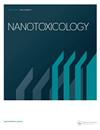Inflammation related to inhalation of nano and micron sized iron oxides: a systematic review.
IF 3.4
3区 医学
Q3 NANOSCIENCE & NANOTECHNOLOGY
引用次数: 0
Abstract
Inhalation exposure to iron oxide occurs in many workplaces and respirable aerosols occur during thermal processes (e.g. welding, casting) or during abrasion of iron and steel products (e.g. cutting, grinding, machining, polishing, sanding) or during handling of iron oxide pigments. There is limited evidence of adverse effects in humans specifically linked to inhalation of iron oxides. This contrasts to oxides of other metals used to alloy or for coating of steel and iron of which several have been classified as being hazardous by international and national agencies. Such metal oxides are often present in the air at workplaces. In general, iron oxides might therefore be regarded as low-toxicity, low-solubility (LTLS) particles, and are often considered to be nontoxic even if very high and prolonged inhalation exposures might result in diseases. In animal studies, such exposures lead to cancer, fibrosis and other diseases. Our hypothesis was that pulmonary-workplace exposure during manufacture and handling of SPION preparations might be harmful. We therefore conducted a systematic review of the relevant literature to understand how iron oxides deposited in the lung are related to acute and subchronic pulmonary inflammation. We included one human and several in vivo animal studies published up to February 2023. We found 25 relevant studies that were useful for deriving occupational exposure limits (OEL) for iron oxides based on an inflammatory reaction. Our review of the scientific literature indicates that lowering of health-based occupational exposure limits might be considered.与吸入纳米级和微米级氧化铁有关的炎症:系统综述。
许多工作场所都会发生吸入氧化铁的情况,在热加工(如焊接、铸造)或钢铁产品磨损(如切割、打磨、机械加工、抛光、砂磨)或处理氧化铁颜料时会产生可吸入气溶胶。只有有限的证据表明,吸入氧化铁会对人体产生不良影响。这与用于钢和铁合金或涂层的其他金属氧化物形成鲜明对比,国际和国家机构已将其中几种金属氧化物列为有害物质。这些金属氧化物通常存在于工作场所的空气中。因此,一般来说,氧化铁可被视为低毒性、低溶解度(LTLS)颗粒,即使长期大量吸入也可能导致疾病,但通常被认为是无毒的。在动物实验中,这种暴露会导致癌症、纤维化和其他疾病。我们的假设是,在生产和处理 SPION 制剂的过程中,肺部在工作场所的接触可能是有害的。因此,我们对相关文献进行了系统回顾,以了解沉积在肺部的氧化铁与急性和亚慢性肺部炎症的关系。我们纳入了截至 2023 年 2 月发表的一项人体研究和多项体内动物研究。我们发现有 25 项相关研究有助于根据炎症反应得出氧化铁的职业接触限值 (OEL)。我们对科学文献的审查表明,可以考虑降低基于健康的职业接触限值。
本文章由计算机程序翻译,如有差异,请以英文原文为准。
求助全文
约1分钟内获得全文
求助全文
来源期刊

Nanotoxicology
医学-毒理学
CiteScore
10.10
自引率
4.00%
发文量
45
审稿时长
3.5 months
期刊介绍:
Nanotoxicology invites contributions addressing research relating to the potential for human and environmental exposure, hazard and risk associated with the use and development of nano-structured materials. In this context, the term nano-structured materials has a broad definition, including ‘materials with at least one dimension in the nanometer size range’. These nanomaterials range from nanoparticles and nanomedicines, to nano-surfaces of larger materials and composite materials. The range of nanomaterials in use and under development is extremely diverse, so this journal includes a range of materials generated for purposeful delivery into the body (food, medicines, diagnostics and prosthetics), to consumer products (e.g. paints, cosmetics, electronics and clothing), and particles designed for environmental applications (e.g. remediation). It is the nano-size range if these materials which unifies them and defines the scope of Nanotoxicology .
While the term ‘toxicology’ indicates risk, the journal Nanotoxicology also aims to encompass studies that enhance safety during the production, use and disposal of nanomaterials. Well-controlled studies demonstrating a lack of exposure, hazard or risk associated with nanomaterials, or studies aiming to improve biocompatibility are welcomed and encouraged, as such studies will lead to an advancement of nanotechnology. Furthermore, many nanoparticles are developed with the intention to improve human health (e.g. antimicrobial agents), and again, such articles are encouraged. In order to promote quality, Nanotoxicology will prioritise publications that have demonstrated characterisation of the nanomaterials investigated.
 求助内容:
求助内容: 应助结果提醒方式:
应助结果提醒方式:


